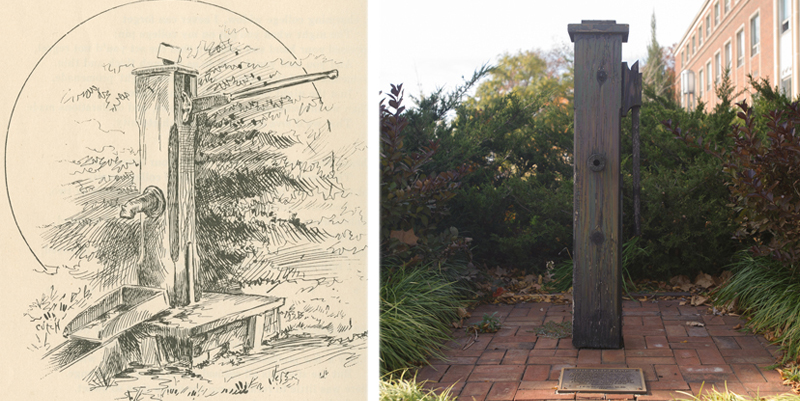Did You Know?: The Old Pump

On the left, an illustration created around 1890 by John T. McCutcheon, an 1889 Purdue alumnus and Pulitzer Prize-winning political cartoonist, shows the Old Pump as it appeared then. On the right is a photo of the pump as it appears now. (Illustration courtesy of Purdue University Archives and Special Collections; Purdue University photo/Matt Thomas)
The antique pump that sits southeast of Stone Hall commemorates a tradition of friendship and romance -- and recalls a custom of youthful pranks -- stretching back to the University's earliest days.
The Old Pump, as it's referred to on its accompanying plaque and in University historical records, actually predates Purdue itself. According to "A University of Tradition: The Spirit of Purdue," a book compiled by the Purdue Reamer Club, the well that's connected to the pump was dug in the 1860s for a local farm family.
After Purdue acquired the land for its West Lafayette campus, administrators knocked down several surrounding buildings but left the well and pump. According to the Reamer Club book, the pump originally was painted green with vivid yellow trimmings, and its connected well was an all-wood cistern. The pump was said to function until 1906, although it eventually was forgotten once a water system was installed on campus.
Early in Purdue's history, the pump sat adjacent to Ladies' Hall, which was a dormitory building for women from 1875 to 1926. As such, student couples used the pretense of getting water from the Old Pump to supplement their dating with "chance meetings."
Further, a well-maintained walk connected the pump to the east steps of Ladies' Hall, according to "The New Purdue," a manuscript written in 1946 by the late George Munro, a Purdue professor of thermodynamics. The walk included sheltering trees and shrubs, and for years, the area was known as "Lovers' Lane."
In addition to its history as a place of romance, the pump was central to the pranks of the "dorm devils," an early 19th-century group of male students who lived in Purdue Hall. According to Robert W. Topping's book "A Century and Beyond: The History of Purdue University," one of the pranksters' favorite tricks involved hiding in the bushes, grabbing unsuspecting passersby and dousing them under the Old Pump.
On one occasion, according to the book, the pranksters accidentally seized President James Smart and placed him under the pump while he tried to protest: "I’m President Smart! I'm President Smart!" Remarkably, Smart did not punish any of the students involved, although they later said they believed Smart surely knew their identities. Smart served as president from 1883 to 1900.
When the pump and its well covering eventually fell into disrepair, the Class of 1893 furnished a new capstone; occasionally, a new wooden pump was installed, according to Munro. In 1927, when Ladies Hall was torn down, President Edward Elliott had the pump reconditioned and placed south of University Hall as a symbol of romance.
In 1958, the Reamer Club returned the pump to its original location at the southeast corner of the Home Economics Building, which later became Stone Hall. The club placed a plaque near the pump that commemorates it as a symbol of romance, friendship and the spirit of Purdue.
The plaque, titled "The Old Pump," reads:
"Older than Purdue itself, this pump was once a meeting place for campus sweethearts. Today it symbolizes romance and friendship and the spirit of Purdue. In recognition of the contribution of the Purdue woman to the preservation of this spirit, this pump is dedicated. Purdue Reamer Club, 1958."
Munro's manuscript, "The New Purdue," is housed in the Virginia Kelley Karnes Archives and Special Collections Research Center.

